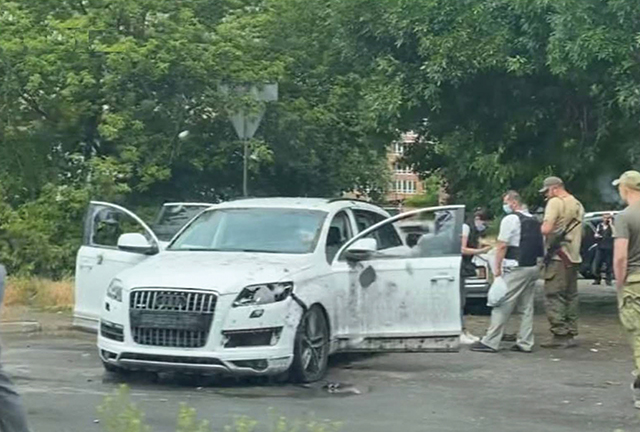Ukrainian and Russian forces clash along the front lines, trading territory and small villages in prolonged combat. However, behind these lines, in Russian controlled territory, Ukrainian citizens have made their disdain pronounced to their occupiers. While many of these events are only partially reported, due to their clandestine nature, they are making life for Russian troops uncomfortable.
Many predicted a resistance effort would be seen, as Russia advanced swiftly in the southern sector. With much of the population still vehemently pro-Kyiv, it was unlikely Russian’s ham-fisted attempts at repression would be successful. As the army passed on to combat Ukrainian regular forces, the Interior Ministry and National Guard troops followed on to assume the work of assimilation.
The southern city of Kherson has been an epicenter for much of the partisan activity. In the early days of the invasion, protestors peacefully took to the streets to oppose the Russian forces. Despite tear gas and shots fired into the air, they eventually succeeded in removing the army from the city.
However, the follow-on forces arrived under the guise of humanitarian aid and reconstruction. Many critics investigating these humanitarian aid packages for the civilian populace found that a significant portion was made up of food items stolen from Ukraine. Taken from other shops in other areas, they had been repackaged and relabeled to show Russia as the great benefactor to the people. This spurred the resistance effort to grow rapidly.
These local resistance units are hard to identify. Naturally, they opt for secrecy and clandestine operations rather than the spotlight. Fighting an occupation army requires such tactics, particularly as the Russian Army moves past and Interior Ministry or Rosgvardia (Russian National Guard) units move in. Neither is known for their soft approach to assimilation.
An exemplary case of this is the occupied city of Kherson. The major shipping and economic center of over 280,000 residents was captured in the first days of March. After 40% of the population left the city, only those willing to capitulate or willing to fight remained. It took little time for the residents to begin their resistance. In the first days of occupation, residents took to the streets to protest the Russian presence. Already, lists were being made of those that might become problematic to the new regime.
The city became a case study for Ukrainian resistance, along with the neighboring southern city of Melitopol. In late April, Ivan Fedorov, the mayor of occupied Melitopol, declared that “According to our intelligence, the deaths of 100 occupiers have been confirmed.”
In Kherson, attacks began with the killing of pro-Russian public figures. On March 20, Pavlo Slobodchikov, a local businessman who worked with the Russian forces, was shot in his car, along with his wife, by an alleged “Ukrainian sabotage group.” Pro-Russian blogger and activist Valery Kuleshov was shot in his car in the early hours of the morning on April 20. It became clear that those that chose the occupation were set to pay a price.
These local fighters have remained in the shadows, but their attacks have intensified as Ukrainian forces have advanced to within 20 km (12.4 miles) of the city. Fedorov stated that “our people are doing everything to make sure the land burns under the feet of the occupiers,” in reference to the resistance efforts ahead of a potential Ukrainian liberation. These efforts have amounted to approximately 100 Russian military or police personnel being killed by these shadow warriors. Poisoned food, grenade attacks, and ambushes on police patrols have all taken their toll.

More recently, the attacks have become more personal. Yevgeny Sobolev, a former Ukrainian jail warden, was attacked by an IED hung from a tree in Kherson in mid-June. While he and his driver were only wounded, it’s reported that he lost the use of his legs in the attack. Former anti-corruption agent Yevgeny Shevchenko commented on the incident saying, “Yevgeny Sobolev, the head of the 90th correctional colony, who went over to the side of the occupiers, has just been liquidated in Kherson – I wonder who killed him?”
The partisans also ambushed Russian service members during a visit to a local cafe in Kherson. According to Ukrainian command, a trio of Russian occupation forces stopped in a waterfront cafe for lunch, during which they were ambushed by unknown assailants. These unknown assailants are purported to be members of the resistance.
These resistance members, based on their tactics and equipment, are likely former members of the military and police. Either being left behind by choice or by circumstance, the resistance members were forced to melt into the populace to avoid the impending purge by Russian authorities. Despite the patrols of occupation forces uncovering Ukrainian weapons and ammunition caches, they remain armed.
Their effectiveness is unclear, but it does in fact pull resources and attention away from conventional operations on the front line. In the case of Kherson, as Ukrainian forces draw near, Russians commanders have to step away to deal with these insurgent attacks. They are forced to spend time, resources, and manpower on these partisan activities while also conducting warfighting missions.
Politically, these resistance movements have significantly shaken the efforts of Russian-backed local leadership to stage a referendum. Efforts to incorporate the region into Russia or form an independent state could be derailed if these asymmetric forces continue to wound or kill members of the occupation. Additionally, it reduces the legitimacy of any “puppet” government put in place if there are routine attacks against this establishment.
However, the organization of the resistance groups is hard to determine. While their very nature is designed to be a shadowy element, there has been little in the way of any symbolism or nomenclature. Kherson’s Russian-backed authorities seem to have done an effective job of suppressing any outreach or online presence of these groups.
In one instance, the so-called Berdyansk Partisan Army has been more outspoken, particularly on Telegram. “Russian occupiers and their collaborators, do you think they have established control over Berdyansk? You still don’t know which mousetrap you got into,” the group posted on the popular encrypted social media channel. They continued with bold claims of their strength by saying “We, the Berdyansk Partisan Army, are already building up our forces and are ready to come out of the shadows.”
While these groups have struck at the underbelly of the rear echelons of the Russian military offensive, their effectiveness is difficult to gauge. While resources and manpower must be rerouted to handle their attacks, it is unlikely to make massive waves on the frontlines. However, should Ukrainian forces make enough headway in the south so as to threaten the city of Kherson, the resistance may allow for a foothold to be made.
As partisan attacks will likely continue, Russian efforts to stabilize and absorb the territories will be exceptionally difficult. Eroding away at the facade of being “welcome liberators,” the Russian military authorities will have to fight a two front war, split between internal and external threats. This split could be, if taken advantage of, the gap in the proverbial armor of the occupation regime.
By Michael Godwin














